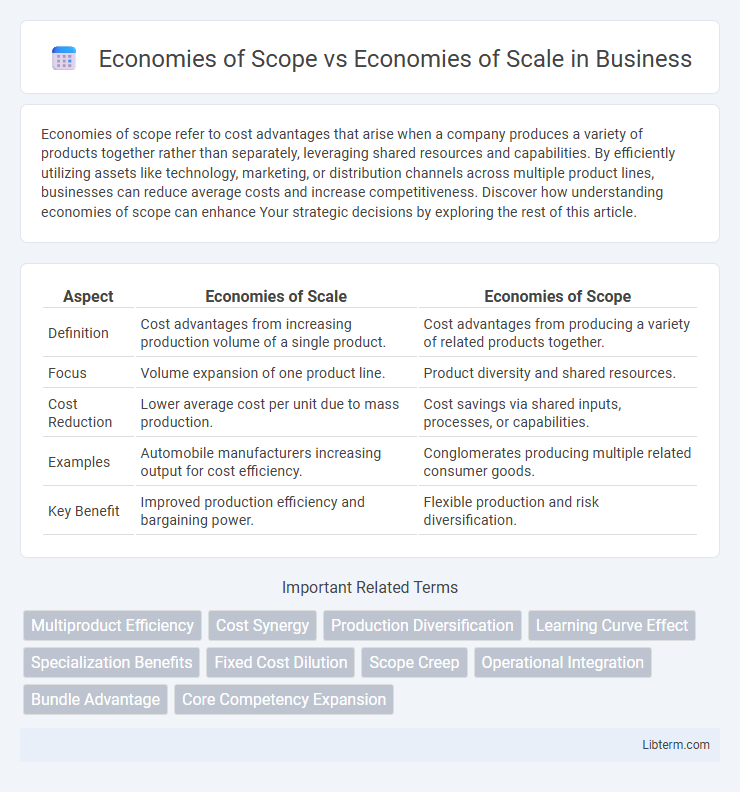Economies of scope refer to cost advantages that arise when a company produces a variety of products together rather than separately, leveraging shared resources and capabilities. By efficiently utilizing assets like technology, marketing, or distribution channels across multiple product lines, businesses can reduce average costs and increase competitiveness. Discover how understanding economies of scope can enhance Your strategic decisions by exploring the rest of this article.
Table of Comparison
| Aspect | Economies of Scale | Economies of Scope |
|---|---|---|
| Definition | Cost advantages from increasing production volume of a single product. | Cost advantages from producing a variety of related products together. |
| Focus | Volume expansion of one product line. | Product diversity and shared resources. |
| Cost Reduction | Lower average cost per unit due to mass production. | Cost savings via shared inputs, processes, or capabilities. |
| Examples | Automobile manufacturers increasing output for cost efficiency. | Conglomerates producing multiple related consumer goods. |
| Key Benefit | Improved production efficiency and bargaining power. | Flexible production and risk diversification. |
Introduction to Economies of Scope and Economies of Scale
Economies of scope occur when a company efficiently produces multiple products together, reducing average costs by utilizing shared resources and capabilities. Economies of scale refer to cost advantages gained by increasing the scale of production, leading to lower per-unit costs through factors like bulk purchasing and specialized labor. Both concepts optimize operational efficiency but differ in focusing on product variety versus production volume.
Defining Economies of Scale
Economies of scale refer to the cost advantages that enterprises obtain due to the scale of their operation, with cost per unit of output generally decreasing with increasing scale. This phenomenon occurs when fixed costs are spread over more units of output, and operational efficiencies improve through specialization and bulk purchasing. In contrast, economies of scope arise from cost savings due to producing a variety of products rather than specializing in a single product.
Understanding Economies of Scope
Economies of scope arise when a company efficiently utilizes its resources to produce a variety of related products, reducing overall costs compared to producing each product independently. This concept emphasizes resource sharing, joint production, and leveraging capabilities across multiple product lines, leading to cost savings through diversification rather than volume expansion. Unlike economies of scale, which focus on cost reduction through increased output of a single product, economies of scope enhance profitability by broadening the product mix and optimizing operational synergies.
Key Differences Between Scope and Scale
Economies of scale refer to cost advantages gained by increasing production volume, which reduces the average cost per unit through fixed cost dilution and operational efficiencies. Economies of scope arise when producing a variety of products together lowers costs compared to producing them separately, leveraging shared resources or technology. The key difference lies in scale focusing on volume increase of a single product, while scope emphasizes cost savings from product diversification and combined output.
Real-World Examples of Economies of Scale
Walmart exemplifies economies of scale by leveraging vast purchasing power to negotiate lower prices from suppliers, reducing per-unit costs across millions of products. Amazon achieves economies of scale through its expansive distribution network and advanced logistics, enabling faster delivery and cost efficiency. Large automobile manufacturers like Toyota benefit from economies of scale by mass-producing vehicles, which spreads fixed costs over high production volumes, lowering average costs.
Real-World Examples of Economies of Scope
Companies like Amazon exemplify economies of scope by leveraging their extensive distribution networks to offer diverse products beyond books, reducing average costs across multiple product lines. Procter & Gamble achieves economies of scope through shared marketing campaigns and research for various consumer goods, enhancing efficiency and innovation. Similarly, Tesla integrates battery technology and electric vehicles production to lower costs while expanding its product portfolio.
Advantages and Disadvantages of Each Approach
Economies of scale offer cost advantages by increasing production volume, leading to lower per-unit costs through fixed cost dilution and operational efficiencies; however, they can result in reduced flexibility and higher risks associated with overdependency on a single product line. Economies of scope reduce costs by leveraging shared resources across multiple products, enhancing diversification and innovation potential but may face challenges such as increased complexity in management and potential inefficiencies from spreading resources too thin. Choosing between economies of scale and scope depends on strategic goals, market conditions, and the firm's capacity to manage operational complexities.
Strategic Implications for Businesses
Economies of scope enable businesses to reduce costs by diversifying product lines and leveraging shared resources across multiple offerings, enhancing competitive advantage through innovation and risk mitigation. In contrast, economies of scale focus on cost reduction via increased production volume, emphasizing operational efficiency and market dominance in a specific product category. Strategic implications include decisions on resource allocation, market expansion, and investment prioritization, where firms must balance the benefits of broad diversification against the efficiencies of specialization to optimize long-term profitability.
Industry Applications: Scope vs. Scale
Industries leveraging economies of scope achieve cost advantages by producing a variety of related products, such as automotive companies manufacturing both cars and trucks to share R&D and marketing expenses. In contrast, industries focused on economies of scale reduce per-unit costs by increasing production volume of a single product, exemplified by semiconductor manufacturers optimizing large-scale chip fabrication. Manufacturing sectors like consumer electronics often balance scope and scale to maximize operational efficiency and competitive advantage.
Choosing the Right Approach for Your Organization
Selecting between economies of scope and economies of scale depends on your organization's product diversity and production capacity. Economies of scope reduce costs by producing a variety of related products using shared resources, ideal for businesses aiming to innovate and expand product lines. Economies of scale focus on cost advantages gained by increasing output volume of a single product, best suited for organizations prioritizing efficiency and mass production.
Economies of Scope Infographic

 libterm.com
libterm.com